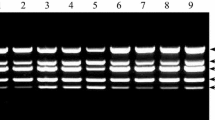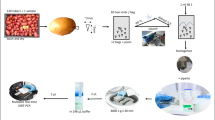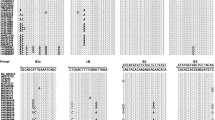Abstract
A TaqMan real-time reverse transcription-PCR (real-time RT-PCR) procedure was developed, optimized, and compared with other routine methods to detect Potato virus Y (PVY) in dormant potato tubers. Three pairs of primers and probes were designed and evaluated for their suitability to facilitate the real-time RT-PCR detection of PVY for all strain groups including PVYO, PVYN, PVYN:O (= PVYN-Wi) and PVYNTN. Among the primer and probe combinations tested, the combination PVY-1 produced the lowest threshold cycle (Ct) value of 25.75. The procedure was further optimized by adjusting various parameters including primer/probe concentration, reaction volume, amplification cycles, and master mixes from different sources. The real-time RT-PCR was then employed to detect PVY from dormant tubers of different cultivars and potato fields, and the results were compared with those obtained from conventional RT-PCR, enzyme-linked immunosorbent assay (ELISA) on sprouts and grow-out testing. Out of 1,069 single-virus infected (PVY only) tubers tested, both formats of RT-PCR detected PVY in 52 samples, ELISA on sprouts in 45, ELISA on leaves in 54 and visual observations in 53. However, in 61 multiple-virus infected tubers tested, both formats of RT-PCR, and ELISA on both sprouts and leaves detected a similar number of positives, thus, making all the methods equally sensitive. Considering that ELISA requires sprouting of dormant potato tubers for PVY testing, grow-out testing takes approximately 6–8 weeks to obtain results, and conventional RT-PCR needs post-PCR processing, real-time RT-PCR offers a speedy alternative for large scale detection of PVY from dormant tubers. The method is therefore recommended for testing of PVY in potato tubers on a commercial scale in a diagnostic laboratory.
Resumen
Se desarrolló y optimizó un procedimiento de transcripción reversa de tiempo real de TaqMan (RT-PCR de tiempo real), y se comparó con otros métodos rutinarios para detectar al virus Y de la papa (PVY) en tubérculos de papa en dormancia. Se designaron tres pares de iniciadores y sondas y se evaluaron para su conveniencia para facilitar la detección de PVY por RT-PCR de tiempo real para todos los grupos de variantes, incluyendo PVYO, PVYN, PVYN:O (=PVYN-Wi) y PVYNTN. Entre las combinaciones probadas de iniciadores y sondas, la combinación de PVY-1 produjo el valor del ciclo del umbral más bajo (Ct) con 25.75. El procedimiento se optimizó mas adelante mediante el ajuste de varios parámetros, incluyendo la concentración iniciador/sonda, volumen de reacción, ciclos de amplificación, y muestras maestras de diferentes fuentes. Se empleó posteriormente el RT-PCR de tiempo real para detectar PVY de tubérculos en dormancia de diferentes variedades y campos de papa, y se compararon los resultados con los obtenidos por la RT-PCR convencional, la serología con enzimas conjugadas (ELISA), en pruebas de brotes y en crecimiento. De 1069 tubérculos probados infectados con un solo virus (PVY solamente), ambos formatos de RT-PCR detectaron PVY en 52 muestras, por ELISA en brotes en 45, por ELISA en hojas en 54, y por observación visual en 53. No obstante, en 61 tubérculos probados con infección múltiple de virus, los dos formatos de RT-PCR y ELISA tanto en brotes como en hojas, detectaron un número similar de positivos, por lo que todos los métodos fueron igualmente sensibles. Considerando que ELISA requiere de brotación en tubérculos en dormancia para la prueba de PVY, las pruebas en crecimiento toman aproximadamente de 6 a 8 semanas para obtener resultados, y el RT-PCR convencional necesita de un proceso post PCR, el RT-PCR de tiempo real ofrece una alternativa mas rápida para detección a gran escala del PVY de tubérculos en dormancia. De aquí que el método es recomendable para pruebas de PVY en tubérculos de papa a escala comercial en un laboratorio de diagnóstico.
Similar content being viewed by others
References
Agindotan, B.O., P.J. Shiel, and P.H. Berger. 2007. Simultaneous detection of potato viruses, PLRV, PVA, PVX and PVY from dormant tubers by TaqMan real-time RT-PCR. Journal of Virological Methods 142: 1–9.
Bustin, S.A. 2000. Absolute quantification of mRNA using real-time reverse transcription polymerase chain reaction assays. Journal of Molecular Endocrinology 25: 169–193.
Ellis, P., R. Stace-Smith, G. Bowler, and D.J. Mackenzie. 1996. Production of monoclonal antibodies for detection and identification of strains of potato virus Y. Canadian Journal of Plant Pathology 18: 64–70.
Fageria, M.S., M. Singh, U. Nanayakkara, D. Wattie, Y. Pelletier, and X. Nie. 2012. Monitoring current season spread of Potato virus Y in seed potato fields. American Journal of Potato Research 89: 30–52 (Abstract).
Gray, S., S. De Boer, J. Lorenzen, A. Karasev, J. Whitworth, P. Nolte, R. Singh, A. Boucher, and H. Xu. 2010. Potato virus Y: an evolving concern for potato crops in the United States and Canada. Plant Disease 94: 1384–1397.
Hartmann, A., M. Senning, P. Hedden, U. Sonnewald, and S. Sonnewald. 2011. Reactivation of meristem activity and sprout growth in potato tubers require both cytokinin and gibberellin. Plant Physiology 155(2): 776–96.
Heid, C.A., J. Stevens, K.J. Livak, and P.M. Williams. 1996. Real-time quantitative PCR. Genome Research 6: 986–994.
Hu, X., C. He, Y. Xiao, X. Xiong, and X. Nie. 2009. Molecular characterization and detection of recombinant isolates of potato virus Y from China. Archives of Virology 154: 1303–1312.
Kogovsek, P., L. Gow, M. Pompe-Novak, K. Gruden, G.D. Foster, N. Boonham, and M. Ravnikar. 2008. Single-step RT real-time PCR for sensitive detection and discrimination of potato virus Y isolates. Journal of Virological Methods 149: 1–11.
Lorenzen, J.H., L. Piche, N.C. Gudmestad, T. Meacham, and P. Shiel. 2006. A multiplex PCR assay to characterize Potato virus Y isolates and identify strain mixtures. Plant Disease 90: 935–940.
McDonald, J.G., and W.K. Coleman. 1988. A reevaluation of bromoethane in comparison to rindite for the post-harvest detection of potato virus Y in tubers by ELISA. American Journal of Potato Research 65(9): 547–550.
Mehle, N., M. Kovac, N. Petrovic, M. Pompe-Novak, S. Baebler, H.K. Stres, K. Gruden, and M. Ravnikar. 2004. Spread of potato virus YNTN in potato cultivars (Solanum tuberosum L.) with different levels of sensitivity. Physiological and Molecular Plant Pathology 64: 293–300.
Mumford, R.A., K. Walsh, I. Barker, and N. Boonham. 2000. Detection of potato mop top virus and tobacco rattle virus using a multiplex real-time fluorescent reverse-transcription polymerase chain reaction assay. Phytopathology 90: 448–453.
Nie, X., and R.P. Singh. 2001. A novel usage of random primers for multiplex RT-PCR detection of virus and viroid in aphids, leaves, and tubers. Journal of Virological Methods 91: 37–49.
Nolte, P., J.L. Whitworth, M.K. Thornton, and C.S. McIntosh. 2004. Effect of seed-borne potato virus Y on performance of Russet Burbank, Russet Norkotah and Shepody potatoes. Plant Disease 88: 248–252.
Rigotti, S., and P. Gugerli. 2007. Rapid identification of potato virus Y strains by one-step triplex RT-PCR. Journal of Virological Methods 140: 90–94.
Russo, P., L. Miller, R.P. Singh, and S.A. Slack. 1999. Comparison of PLRV and PVY detection in potato seed samples tested by Florida winter field inspection and RT-PCR. American Journal of Potato Research 76: 313–316.
Singh, R.P. 1999. Development of the molecular methods for potato virus and viroid detection and prevention. Genome 42: 592–604.
Singh, M., and R.P. Singh. 1995. Digoxigenin-labelled cDNA probes for detection of potato virus Y in dormant tubers. Journal of Virological Methods 52: 133–143.
Singh, R.P., and X. Nie. 2003. Multiple virus and viroid detection and strain separation via multiplex reverse transcription-polymerase chain reaction. Canadian Journal of Plant Pathology 25: 127–134.
Singh, M., R.P. Singh, and L. Moore. 1999. Evaluation of NASH and RT-PCR for the detection of PVY in dormant tubers and its comparison with visual symptoms and ELISA in plants. American Journal of Potato Research 76: 61–66.
Singh, R.P., X. Nie, and M. Singh. 2000. Duplex RT-PCR: Reagent concentrations at reverse transcription stage affect the PCR performance. Journal of Virological Methods 86: 121–129.
Singh, R.P., X. Nie, M. Singh, R. Coffin, and P. Duplessis. 2002. Sodium sulfite inhibition of potato and cherry polyphenolics in nucleic acid extraction for virus detection by RT-PCR. Journal of Virological Methods 99: 123–131.
Singh, R.P., D.L. McLaren, X. Nie, and M. Singh. 2003. Possible escape of a recombinant isolate of Potato virus Y by serological indexing and methods of its detection. Plant Disease 87: 679–685.
Singh, R.P., A.D. Dilworth, M. Singh, and D.L. McLaren. 2004. Evaluation of a simple membrane-based nucleic acid preparation protocol for RT-PCR detection of potato viruses from aphid and plant tissues. Journal of Virological Methods 121: 163–170.
Singh, M., R.P. Singh, and R. Coffin. 2006. Real-time PCR assay for the detection of potato viruses in a triplex format. Canadian Journal of Plant Pathology 28: 328 (Abstract).
Singh, R.P., J.P. Valkonen, S.M. Gray, N. Boonham, R.A. Jones, C. Kerlan, and J. Schubert. 2008. Discussion paper: The naming of Potato virus Y strains infecting potato. Archives of Virology 153: 1–13.
Valasek, M.A., and J.J. Repa. 2005. The power of real-time PCR. Advances in Physiology Education 29: 151–159.
Acknowledgements
Authors would like to thank National Research Council Canada under Industrial Research Assistance Program (NRC-IRAP), and New Brunswick Department of Agriculture and Aquaculture for funding; Angela Gallagher, Julie McAllister, Beata Chledowski, and Heather Olsen for their technical help.
Author information
Authors and Affiliations
Corresponding author
Rights and permissions
About this article
Cite this article
Singh, M., Singh, R.P., Fageria, M.S. et al. Optimization of a Real-Time RT-PCR Assay and its Comparison with ELISA, Conventional RT-PCR and the Grow-out Test for Large Scale Diagnosis of Potato virus Y in Dormant Potato Tubers. Am. J. Potato Res. 90, 43–50 (2013). https://doi.org/10.1007/s12230-012-9274-z
Published:
Issue Date:
DOI: https://doi.org/10.1007/s12230-012-9274-z




